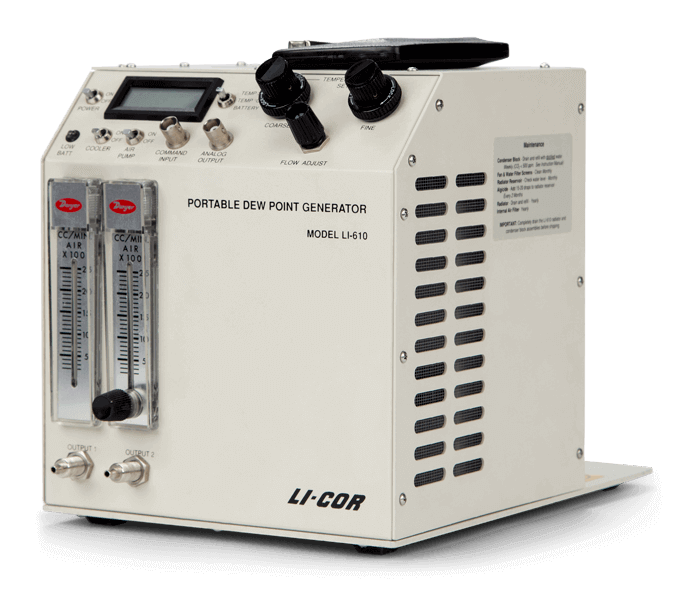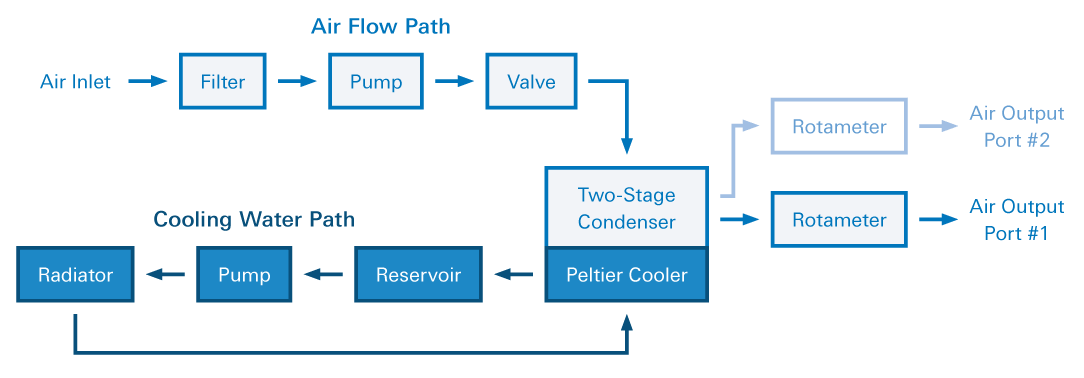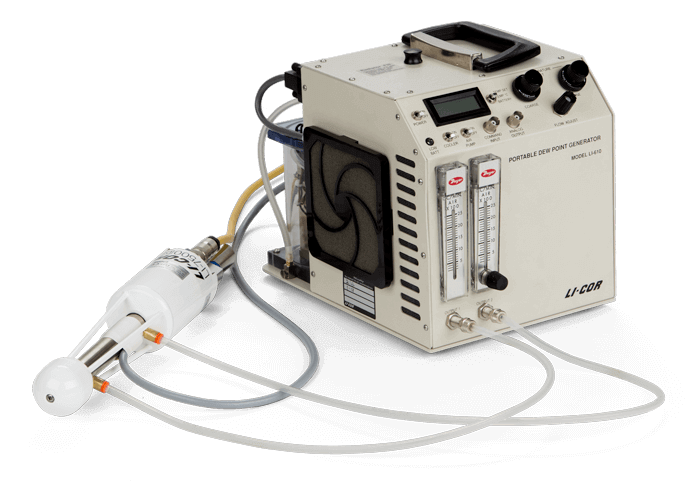LI-610 Portable Dew Point Generator
The LI-610 Dew Point Generator has been discontinued. If you own an LI-610, you can get support here.
The LI-610 Portable Dew Point Generator is a rugged, portable instrument that provides a stream of gas with a precisely controlled dew point. High accuracy and stability make the LI-610 an ideal water vapor source for field or laboratory use in the environmental and biological sciences. The LI-610 is commonly used to calibrate the H2O channel of gas analyzers or other precision sensors, and provide precise control over water vapor mole fraction in environmentally regulated chambers.
- NIST certified
- Generates stable dew points from 0 to 50 °C
- Accuracy of ± 0.2 °C dew point
- Completely portable and self-contained (battery or AC operated)
- No need for gas tanks and mixing systems
- Millivolt output of dew point temperature for data acquisition
- External control via 0-5 V input signal

Features
Portability
The LI-610 is completely portable with power supplied from the 6200B Rechargeable Battery (optional), or any 12-volt battery. The 6200B provides approximately 4 hours of continuous battery powered operation at 25 °C ambient air temperature and 10 °C dew point. The 6200B requires the LI-6020 Battery Charger for recharging.
For laboratory use, the LI-610 is powered by line voltage (108-126 VAC or 216-252 VAC) using the 610-01 AC Module (included).
Low Maintenance
Routine maintenance consists only of changing the water in the condenser block (weekly under normal operating conditions). Under typical operating conditions, the LI-610 can provide 4 to 8 hours of continuous operation before the condenser needs to be refilled.
Easy Flow Adjustments
A valve on the front panel adjusts the flow rate through two gas exit ports (typically, combined total of 2.0 liters per minute). Rotameters monitor, adjust, or equalize the flow through each exit port.
LCD Display
The LI-610 has an easy-to-read 4 1/2-digit display with 0.01 °C display resolution. Coarse and fine adjustment knobs allow dew point temperature to be set precisely. Actual dew point temperature and battery voltage can also be displayed.

Operation
To generate a stable dew point, an air stream is bubbled through water reservoirs in two nickel-plated condensers to completely saturate the air with water vapor. The temperature of each condenser is precisely controlled to the target dew point by Peltier thermoelectric coolers. An internal radiator with a cooling fan dissipates heat from the coolers, providing a completely self-contained cooling system.
The condenser temperature is precisely measured by using a Platinum Resistance Temperature Detector (RTD). Temperature calibration accuracy is established through transfer calibrations using National Institute of Standards and Technology (NIST) recommended methods and NIST-traceable devices.
The water vapor stream exits the condensers via a port on the front panel (designed for 1/8 inches or 4 mm ID tubing) or can be split to a second port. An internal pump provides typical flow rates of 0 to 2.0 liters per minute.
NIST calibration of the LI-610 Portable Dew Point Generator
| NIST Dew Point (°C) | LI-610 Pressure Corrected Dew Point (°C) | Error (LI-610/NIST) (°C) | LI-610 Indicated Dew Point (°C) | Flow Rate (cc/min) |
|---|---|---|---|---|
| 0.81 | 0.92 | +0.11 | 1.00 | 1000 |
| 0.83 | 0.96 | +0.13 | 1.00 | 500 |
| 9.78 | 9.91 | +0.13 | 10.00 | 1000 |
| 9.80 | 9.96 | +0.16 | 10.00 | 500 |
| 19.80 | 19.95 | +0.15 | 20.00 | 500 |
| 19.78 | 19.90 | +0.12 | 20.00 | 1000 |
| 19.74 | 19.84 | +0.10 | 20.00 | 2500 |
Note: Common operating flow rates cause small over-pressures to develop in the LI-610 condenser that exceed ambient pressure. The magnitudes of the over-pressure depend upon the flow rates used and the resistance to flow of any equipment or tubing attached to the LI-610 output. Small over-pressures (e.g. 10 kPa or less) have no appreciable effect on the vapor pressure or dew point of air in the condenser, but the mixing ratio will be affected because the carrier gas will be compressed slightly. When the moistened air leaves the LI-610, it will expand to ambient pressure, causing the vapor pressure and dew point to drop below the condenser set point while the mixing ratio remains constant. The vapor pressure of the exit airstream can be estimated by multiplying the saturation vapor pressure at the LI-610 setpoint temperature by the ratio P / (P + deltaP), where deltaP is the pressure difference between the condenser and ambient air pressure.
This correction derives from fundamental principles, not an instrumental error. The magnitude of the correction can be minimized by operating at low flow rates and by keeping the flow resistance of plumbing and equipment attached to the LI-610 outlet to a minimum. The LI-610 has a built-in water manometer that allows pressure measurements up to about 6 cm of water (0.6 kPa). This is sufficient for most calibrations at flow rates below about 0.5 liters per minute. A digital manometer can be used when operating conditions generate larger condenser pressures.
Applications
Calibrating Instruments
The LI-610 can be used to calibrate the H2O channels on gas analyzers. An air stream from the LI-610 is directed through a desiccant to set the analyzer's zero, and a second airstream is used to set the span.
The high accuracy and stability of the LI-610 make it an excellent instrument to calibrate relative humidity sensors and to check the calibration of dew point hygrometers. An equation is provided to convert dew point temperature to relative humidity, assuming that temperature is accurately measured. A chart is also provided for quick conversions in the field (see LI-610 Reference Card on the Instruction Manual page).
Controlling Humidity During Photosynthesis Measurements
The LI-610 can provide a continuous air stream of known dew point to photosynthesis and stomatal conductance measurement chambers, or for other applications where a known supply of water vapor is required.
Maintaining Humidity in Chambers
A carefully controlled dew point can be used to maintain conditions in chambers, and to calibrate sensors in enclosures.

Data communications
Voltage output
The LI-610 provides a linear analog output, which allows data acquisition systems to record the dew point temperature. The 0 to 50 °C dew point range corresponds to a 0 to 5 V output range (100 mV / °C ).
External Control
In addition to front panel controls, dew point temperature can be set by sending a linear 0 to 5 V signal to the Command Input connector on the front of the panel. By using an input signal to control the LI-610 , an automated calibration system can cycle through a range of dew points while calibrating humidity measurement instruments. The LI-610 measures the input voltage and sets the dew point accordingly (100 mV / °C ).